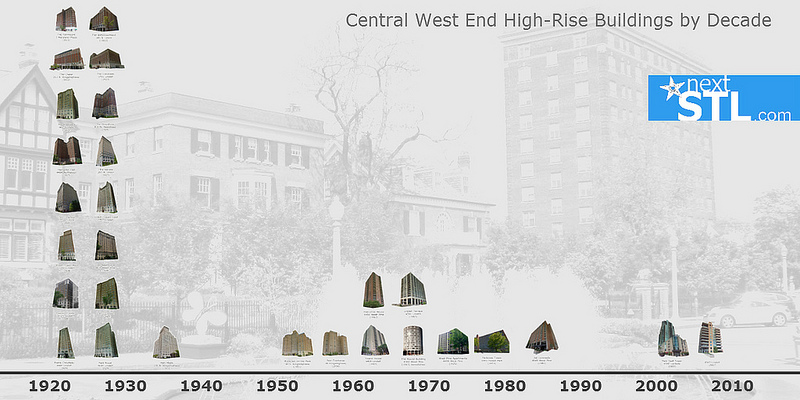
With new towers planned, proposed or rumored, we take a look back at the history of high rise living in the Central West End of St. Louis. The first residential building to reach ten stories in the neighborhood was the Fairmont in 1921, which originally faced Euclid but now is oriented toward Maryland Plaza. Since that time, 27 other apartment, residential hotel and condo buildings have risen nearby. Here we chart out a century of vertical living in the city’s favorite neighborhood.
A lot of these buildings originally were ‘residential hotels.’ Such structures formed a third category between our modern notion of a nightly hotel and our notion of an apartment. While you could get a room for a night at a residential hotel, these buildings had weekly and monthly rates and a lot of long-term residents. They provided larger units like an apartment building, but offered the amenities of a hotel. Many successful professionals lived their entire lives in residential hotels. It was a fairly common lifestyle choice for single professionals (male and female) who had no spouse to do the housekeeping.
Seeing these towers divorced from their urban context triggers a lot of thoughts about the buildings that help define the city. You’re reminded that the amazing urban wall on the north side of Lindell Blvd. actually consists of nearly a dozen individual buildings. Even tall buildings can function to define an urban space — to say that the whole is greater than the sum of its parts, that each piece of our built environment must defer and yield to the creation of this living entity we call the city.
A visual timeline also lets you view these structures in the context of one other. You notice how so many of them look so very alike. You notice the familiar tripartite form with stone or terra cotta base, red or tan brick shaft and terra cotta top. And you can observe how the repetition of this form creates a foil against which the truly exceptional is recognized. You notice the fantastic vertical banding of the Pierre Chouteau. You see the stepped ziggurat of the Park Plaza. You admire the elegantly executed modernism of Lindell Terrace. And — at least in your memory — you might notice the quirky form of the Round Building, that now-demolished roll of paper towels that once stood out on the Central West End skyline. It was a building you either loved or hated. Or you loved it from a distance but hated it up close.
Seeing the timeline, you also realize how loudly the 1920s roared in St. Louis … and how silent things became after the 1931 opening of the Park Plaza, that swan song of a booming era. You see the twenty year silence during depression and war, the burst of new life in the 1960s followed again by thirty years of relative quiet.
And then you notice the new towers: the Park East on Euclid and the building at 4545 Lindell. Then you think of the proposed Covington tower at 4494 Lindell and hear rumblings of perhaps others on the way. You wonder whether the Twenties and Sixties might be followed by the roaring Tens. Unable to see where the timeline leads beyond the present, you still look at these newer projects — at the investment and people and relationships they represent — and you ponder whether the Central West End has entered a new golden age of growth and vitality.


